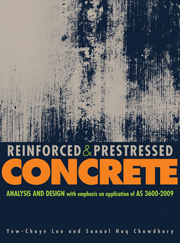Book contents
- Frontmatter
- Contents
- Preface
- Acknowledgements
- Notation
- Acknowledgements for tables and diagrams
- Acronyms and abbreviations
- Part I Reinforced concrete
- Part II Prestressed concrete
- 12 Introduction to prestressed concrete
- 13 Critical stress state analysis of beams
- 14 Critical stress state design of beams
- 15 Ultimate strength analysis of beams
- 16 End blocks for prestressing anchorages
- Appendix A Elastic neutral axis
- Appendix B Critical shear perimeter
- Appendix C Development of an integrated package for design of reinforced concrete flat plates on personal computer
- Appendix D Strut-and-tie modelling of concrete structures
- Appendix E Australian Standard precast prestressed concrete bridge girder sections
- References
- Index
13 - Critical stress state analysis of beams
from Part II - Prestressed concrete
- Frontmatter
- Contents
- Preface
- Acknowledgements
- Notation
- Acknowledgements for tables and diagrams
- Acronyms and abbreviations
- Part I Reinforced concrete
- Part II Prestressed concrete
- 12 Introduction to prestressed concrete
- 13 Critical stress state analysis of beams
- 14 Critical stress state design of beams
- 15 Ultimate strength analysis of beams
- 16 End blocks for prestressing anchorages
- Appendix A Elastic neutral axis
- Appendix B Critical shear perimeter
- Appendix C Development of an integrated package for design of reinforced concrete flat plates on personal computer
- Appendix D Strut-and-tie modelling of concrete structures
- Appendix E Australian Standard precast prestressed concrete bridge girder sections
- References
- Index
Summary
Assumptions
By definition, a fully prestressed beam sustains neither tensile cracking nor overstress in compression, under any given service load. Achieving these no-crack and no-overstress conditions throughout the working life of a beam – when prestress losses occur instantaneously and continuously – is a complicated problem. The critical stress state (CSS) approach presented in this chapter provides a fool-proof solution to this otherwise intractable problem. It is a linear-elastic method and is valid subject to the following assumptions:
plane section remains plane after bending
material behaves elastically
beam section is homogenous and uncracked
the principle of superposition holds.
Notation
Figure 13.2(1)a illustrates a typical section of a prestressed I-shaped bridge beam. It may be idealised as shown in Figure 13.2(1)b in which the resultant H of the individual prestressing forces is located at the effective centre of prestress, or with an eccentricity (eb) from the neutral axis (NA). The effective centre is the centre of gravity (action) of the individual prestressing forces. Its location, or the value of eb, can be determined by simple statics.
To develop the CSS equations in a systematic manner, specific notation needs to be followed. As shown in Figure 13.2(1)b, the eccentricity (e) is positive upwards and negative downwards. Consequently, the moment with respect to NA created by H is –Heb. The sign convention for the beam moment is given in Figure 13.2(2) that is, positive (+) where it produces compression above NA, and tension, below it.
- Type
- Chapter
- Information
- Reinforced and Prestressed ConcreteAnalysis and Design with Emphasis on Application of AS3600-2009, pp. 329 - 347Publisher: Cambridge University PressPrint publication year: 2010



